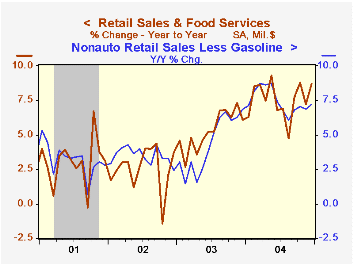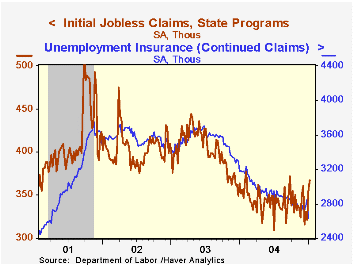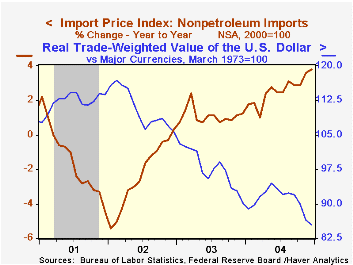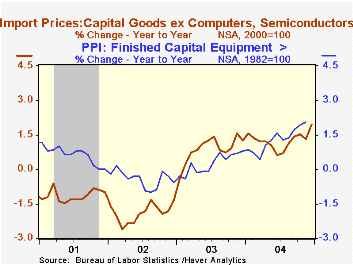 Global| Jan 13 2004
Global| Jan 13 2004U.S. Retail Spending Boosted By Vehicle Sales
by:Tom Moeller
|in:Economy in Brief
Summary
US retail sales surged 1.2% in December on the strength of a 4.3% (8.9% y/y) jump in spending on motor vehicles. Consensus expectations had been for a 1.0% gain following the 0.1% rise in November sales which was unrevised. Sales [...]

US retail sales surged 1.2% in December on the strength of a 4.3% (8.9% y/y) jump in spending on motor vehicles. Consensus expectations had been for a 1.0% gain following the 0.1% rise in November sales which was unrevised.
Sales excluding motor vehicles rose 0.3% but the 0.4% gain in November sales was slightly lower than initially reported. Consensus expectations had been for a 0.4% increase.
Lower prices for gasoline dropped sales at gasoline service stations 2.0% (+21.8% y/y). Nonauto retail sales less gasoline jumped 0.6% (7.2% y/y). After a 7.0% decline in December, gasoline prices are 3.0% lower in January.
Gains in discretionary spending centered on a 1.0% (4.9%) rise in sales of furniture/home furnishings & electronics/appliances that was driven by a 2.2% (6.4% y/y) jump in spending on furniture. Sales at general merchandise stores also rose a firm 0.7% (7.0% y/y). Clothing & accessory store sales slipped for the second month, by 0.6% (3.3% y/y) following a revised 0.8% decline in November that was much deeper than initially estimated.
Building materials, garden equipment & supply dealers' sales jumped 1.2% (13.2% y/y).
| Dec | Nov | Y/Y | 2004 | 2003 | 2002 | |
|---|---|---|---|---|---|---|
| Retail Sales & Food Services | 1.2% | 0.1% | 8.7% | 7.6% | 5.3% | 2.5% |
| Excluding Autos | 0.3% | 0.4% | 8.6% | 8.5% | 5.2% | 3.2% |
by Tom Moeller January 13, 2005

Initial claims for unemployment insurance rose 10,000 to 367,000 last week but the sharp gain the prior week was lessened slightly to 35,000. Consensus expectations had been for a decline to 340,000 claims.
The four week moving average of initial claims rose to 344,000 (-3.6% y/y).
During the last ten years there has been a (negative) 82% correlation between the level of initial claims and the y/y change in payroll employment.
Continuing claims for unemployment insurance fell a huge 219,000 following an upwardly revised 71,000 increase the week prior.
The insured rate of unemployment fell to 2.1% from an upwardly revised 2.3% the week prior.
"Why Are Married Women Working More? Some Macroeconomic Explanations" from the Federal Reserve Bank of Philadelphia is available here.
| Unemployment Insurance (000s) | 01/08/05 | 01/01/05 | Y/Y | 2004 | 2003 | 2002 |
|---|---|---|---|---|---|---|
| Initial Claims | 367 | 357 | 4.3% | 343 | 402 | 404 |
| Continuing Claims | -- | 2,631 | -17.3% | 2,926 | 3,531 | 3,570 |
by Tom Moeller January 13, 2005

Import prices fell 1.3% last month due to sharply lower prices for petroleum. The Consensus expectation had been for a 0.4% decline. Nonpetroleum prices, however, rose 0.5% and raised the y/y increase to 3.8%, its highest since 1995.
During the last ten years there has been a (negative) 55% correlation between the level of the dollar and the y/y change in nonpetroleum import prices.
Import pricing strength in December was most pronounced for foods, feeds & beverages which rose 1.0% (7.8% y/y). Gains elsewhere were more moderate, but up moderately from earlier lows. 
Capital goods prices rose 0.3% and the y/y change rose to -0.9% versus earlier 2% to 8% rates of decline. Excluding computers capital goods prices rose 0.5% and the y/y gain of 1.9% compared to price deflation of 1.9% in 2002 and of 4.2% during 1997. Non-auto consumer goods import prices rose 0.3% and the y/y change rose to 0.7% versus a peak rate of decline of 1.6% in early 2002.
Petroleum prices fell 1.5% as the price of Brent crude oil fell to $39.12 in December. It rose to $43.16 last week.
Export prices rose 0.2%. Nonagricultural export prices rose 0.1% (4.9% y/y).
| Import/Export Prices (NSA) | Dec | Nov | Y/Y | 2004 | 2003 | 2002 |
|---|---|---|---|---|---|---|
| Import - All Commodities | -1.3% | -0.2% | 6.9% | 5.7% | 2.9% | -2.5% |
| Petroleum | -11.5% | -5.7% | 30.8% | 30.6% | 21.0% | 3.0% |
| Non-petroleum | 0.5% | 0.9% | 3.8% | 2.6% | 1.1% | -2.4% |
| Export - All Commodities | 0.2% | 0.3% | 4.1% | 3.9% | 1.6% | -1.0% |
by Tom Moeller January 13, 2005

The Small Business Optimism Index published by the National Federation of Independent Business (NFIB) slipped 1.5% in December from the twenty year high to 106.1.
During the last ten years there has been a 68% correlation between the level of the NFIB index and the two quarter change in real GDP.
The percentage of firms expecting the economy to improve fell ten points to 37 but the 4Q level was the highest of the year. The percent of firms planning to raise employment also fell to a still high 17%. During the last ten years there has been a 65% correlation between these hiring plans and the three month growth in nonfarm payrolls. The percentage of firms with one or more job openings rose back to 23%, the highest level since 2001. 
The percentage of firms expecting higher real sales in 6 months remained at an elevated 35%. The net of firms expecting higher earnings this quarter slipped.
The percentage of firms raising average selling prices fell to 15%, the lowest since February.
About 24 million businesses exist in the United States. Small business creates 80% of all new jobs in America.
| Nat'l Federation of Independent Business | Dec | Nov | Y/Y | 2004 | 2003 | 2002 |
|---|---|---|---|---|---|---|
| Small Business Optimism Index (1986=100) | 106.1 | 107.7 | -0.7% | 104.6 | 101.3 | 101.2 |
Tom Moeller
AuthorMore in Author Profile »Prior to joining Haver Analytics in 2000, Mr. Moeller worked as the Economist at Chancellor Capital Management from 1985 to 1999. There, he developed comprehensive economic forecasts and interpreted economic data for equity and fixed income portfolio managers. Also at Chancellor, Mr. Moeller worked as an equity analyst and was responsible for researching and rating companies in the economically sensitive automobile and housing industries for investment in Chancellor’s equity portfolio. Prior to joining Chancellor, Mr. Moeller was an Economist at Citibank from 1979 to 1984. He also analyzed pricing behavior in the metals industry for the Council on Wage and Price Stability in Washington, D.C. In 1999, Mr. Moeller received the award for most accurate forecast from the Forecasters' Club of New York. From 1990 to 1992 he was President of the New York Association for Business Economists. Mr. Moeller earned an M.B.A. in Finance from Fordham University, where he graduated in 1987. He holds a Bachelor of Arts in Economics from George Washington University.






